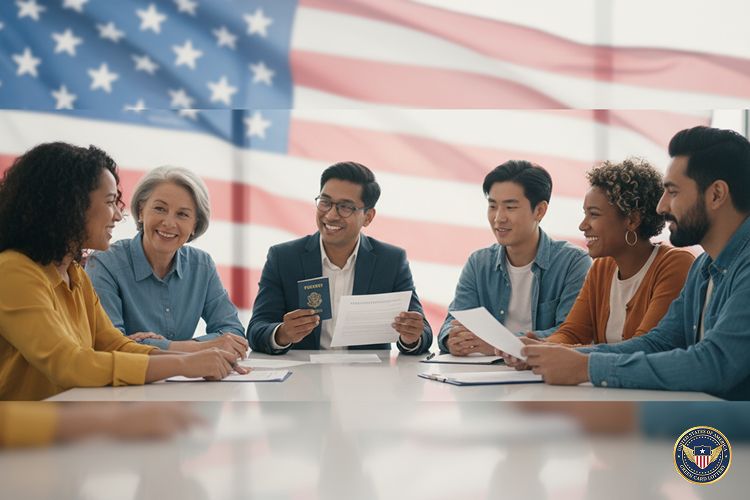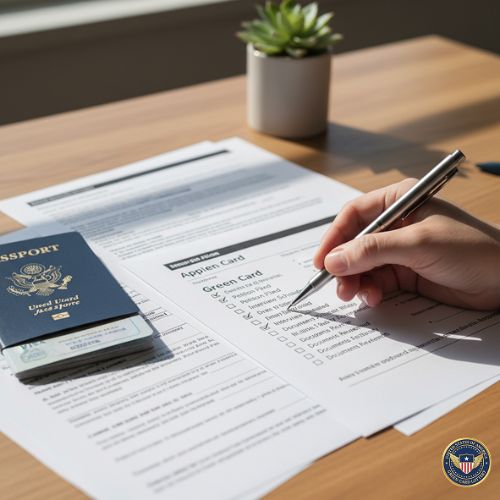
Applying for a Green Card is one of the most essential steps toward becoming a lawful permanent resident of the United States. Whether your goal is to work, study, start a business, reunite with your family, or permanently build a new life in the U.S., understanding the Green Card Application process clearly can help you avoid delays, mistakes, and rejections.
There are several paths to obtaining a U.S. Green Card, including family-based sponsorship, employment-based visas, and the Diversity Visa Lottery (also known as the Green Card Diversity Lottery). Each path has different eligibility rules, document requirements, and processing timelines.
This guide breaks down the entire Green Card Application process step-by-step, explains different eligibility categories, and provides helpful tips to make your application stronger and more successful.

1. What Is a Green Card and Why Is It Important?
A Green Card is an identity card issued by the U.S. government that grants you lawful permanent residency. With permanent residency, you can:
- Live anywhere in the United States
- Work for any employer (without sponsorship restrictions)
- Start a business legally
- Travel in and out of the U.S. more freely
- Apply for U.S. citizenship after meeting residency requirements
This makes the Green Card Application one of the most desired immigration processes worldwide.

2. Different Ways to Apply for a Green Card
Your Green Card Application pathway depends on your circumstances. The main categories include:
A. Family-Based Green Card
If you have close family members who are U.S. citizens or permanent residents, they can sponsor you.
Eligible relationships include:
- Spouse
- Parents
- Children (under 21)
- Fiancé(e) (K-1 visa category)
- Adult children or siblings (waiting times vary)
B. Employment-Based Green Card
You may qualify through:
- Job offer from a U.S. employer
- Extraordinary abilities in science, education, business, or the arts
- Investment of capital (EB-5 investor visa)
Some applicants in the H-1 B Visa Lottery eventually transition to Green Cards through employment-based categories.
C. Diversity Visa Lottery (Green Card Lottery)
This is the Diversity Immigrant Visa Program, commonly known as the Green Card Diversity Lottery, which allows individuals from countries with low rates of immigration to the U.S. to apply.
Every year, 55,000 visas are issued through this program.
This pathway is more straightforward because:
- No job sponsorship is required
- No family sponsorship is required
- Selection is based on a random computerized draw
Services like US Green Card Office help applicants correctly apply for the Diversity Visa Lottery and avoid mistakes that commonly lead to disqualification (such as incorrect photos or missing details). They also accept applications all year, even when the government website is closed.
D. Refugee, Asylee, or Humanitarian Programs
This option applies to individuals who were granted asylum or refugee status in the U.S.
After one year of residency, they can apply for a Green Card.

3. Step-by-Step Green Card Application Process
The exact process depends on your category, but generally follows these steps:
Step 1: Determine Eligibility
You must fall under one of the lawful immigration categories.
Many applicants use the Green Card Lottery if they do not have family or job sponsorship options.
Step 2: File a Petition
Someone must usually file a petition for you:
- Family-based: Form I-130
- Employment-based: Form I-140
- Diversity Visa: No petition; you must submit an official lottery entry form
Step 3: Wait for Your Priority Date
Most applicants wait for a visa number to become available based on their category.
Diversity Visa winners move faster because visas are pre-allocated each year.
Step 4: Complete the Green Card Application
This step involves submitting:
- Form I-485 (Adjustment of Status) if you are already inside the U.S.
- Or attending a U.S. Embassy Visa Interview if applying from abroad.
This stage also requires:
- Birth certificate
- Passport
- Police clearance
- Medical examination
- Financial documents
Step 5: Attend Biometrics Appointment
USCIS conducts fingerprinting and background checks.
Step 6: Attend the Visa Interview
A consular officer or USCIS officer verifies your:
- Identity
- Eligibility
- Travel intentions
- Supporting documents
Answer honestly and confidently.
Step 7: Receive Decision
If your application is approved:
You will receive your Green Card by mail.
If additional evidence is needed:
📄 USCIS may request more documents.
If denied:
❌ You may appeal or reapply depending on the reason.

4. How Long Does the Green Card Application Process Take?
Processing time depends on your category and the country you are applying from.
Average timeline ranges from 8 months to 2 years or longer.
Diversity Lottery winners move faster because visas expire in the same fiscal year; they must act quickly.
5. How the Green Card Lottery Helps Applicants Without Sponsors
For many people, the most challenging part of the Green Card Application is finding a sponsor.
The Diversity Visa Lottery is the only path where:
- No employer is needed
- No family sponsor is required
- No job offer is required
This is why millions participate every year.
Using a professional application service (such as US Green Card Office) helps applicants avoid costly mistakes and provides peace of mind.
Conclusion
The Green Card Application process can seem complex, but with the proper guidance and preparation, it becomes far more manageable.
If you:
- Have a U.S. sponsor → Apply through family or employment
- Do not have a sponsor → Your best legal path is the Diversity Visa Lottery
Organizations like the US Green Card Office assist applicants throughout the process, from submitting a winning lottery application to preparing documentation after selection, helping reduce mistakes that can lead to rejection.
If you are ready to begin your journey:
✅ Learn your eligibility
✅ Prepare documents carefully
✅ Submit your application correctly
Your future in the United States starts with one step
Your Green Card Application.


